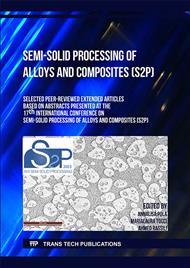p.1
p.7
p.15
p.21
p.27
p.33
p.39
p.47
Study on Processing Conditions for Semi-Solid Forging of Magnesium Alloys
Abstract:
Magnesium alloy castings are mainly formed by the die casting method, but this method has the disadvantage that product properties such as strength vary due to many defects inherent in casting. In this study, AZX912 (a flame-retardant magnesium alloy with 2% calcium added to AZ91D alloy) was semi-solid forged using a servo press and die cushion system to stabilize product properties. Experiments were conducted to refine the α-phase and reduce the yield point, and the stirring speed was changed and its effect was investigated. Observation of the microstructure of the molded product using an optical microscope showed that the average grain size of the α-phase became smaller as the stirring speed increased. Tensile tests were conducted on specimens cut from the compacts, and the yield point increased as the stirring speed increased. This is thought to be due to compliance with Hall Petch's law. The microstructure of the molded product was observed under an optical microscope and showed a three-layer structure with a dendrite shape in the upper part (about 5%), a grain structure in the middle part (over 90%), and a chill layer in the lower part (less than 5%). Comparison of the thickness of the chill layer showed that the thickness of the chill layer decreased as the solidus ratio increased.
Info:
Periodical:
Pages:
21-26
Citation:
Online since:
August 2023
Keywords:
Price:
Сopyright:
© 2023 Trans Tech Publications Ltd. All Rights Reserved
Share:
Citation:



